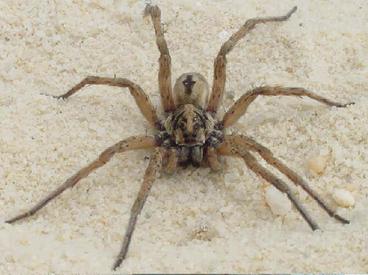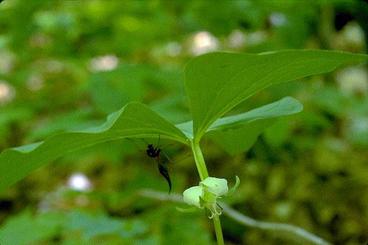The term macroinvertebrates refers to organisms large enough to see without magnification (macro) that have no vertebra (back bone) and include such organisms as snails & slugs, spiders and a whole range of forest floor and soil insects. Recent research from the woodlands around the Chicago area has shown that following earthworm invasion, the diversity and abundance of macroinvertebrate populations can decline dramatically. It is not yet known how this may affect other organisms that rely on these species for food.
Land snails (as opposed to aquatic snails) come in dozens of species in hardwood forests across the Great Lakes Region, but the species and their population dynamics are only beginning to be more fully appreciated. Native land snails are in decline in many areas while exotic slugs (the common European garden slug) appear to thrive and expand once earthworms invade. Research has implicated these small but slimy creatures as playing a role in the decline of native forest plants.

Spiders of hardwood forests are also numerous, such as Orb Weaver spiders that spin large "orb" webs between trees and branches, "Jumping" spiders that pounce on prey, and "Forest Wolf" spiders which do not spin webs but rather burrow in the forest floor and upper soil and hunt at night. Little (if any) research has been conducted investigating the impacts of earthworm invasion on spider populations. But it seems likely that they could be negatively affected by the loss of the forest floor and declines in other macroinvertebrates that they feed on.
Insects crawl and fly through the understory eating plants and each other. Insects play an important role by pollinating plant life in the forest and surrounding areas. They are also a food source for other invertebrates, birds and some mammals. Ants, beetles, butterflies, flies, bees, and wasps are all important pollinators for hardwood forest plant life. For example, "Ichneumonid" wasps rely on rotting logs for food and shelter. These wasps lay their eggs on the larvae of other insects living in logs. Without the rotting logs, it would be difficult for these wasps to survive. In fact, bees, ants, beetles, and wasps all rely on rotting logs for survival. A rotting log is a crowded place! While the number of logs in a forest may not decline in the wake of earthworm invasion, anecdotal observations suggest that without the forest floor to hold and maintain moisture, logs may dry out more rapidly which greatly slows their rotting process and makes it hard for insects to use them. Most insectsliving in hardwood forests rely upon the forest floor for food and protection. Since earthworms eliminate the forest floor, we would expect that not only the numbers of insects will decrease, but the variety of insects will also decrease.

More research is needed to put some hard numbers behind these fleeting observations.